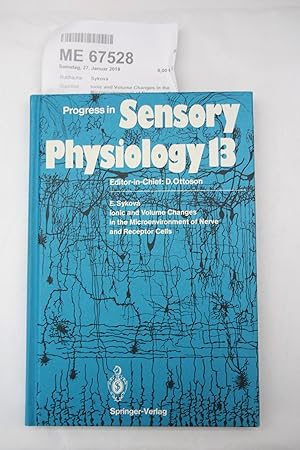ionic volume microenvironment nerve von sykova eva (4 Ergebnisse)
Suchfilter
Produktart
- Alle Product Types
- Bücher (4)
- Magazine & Zeitschriften (Keine weiteren Ergebnisse entsprechen dieser Verfeinerung)
- Comics (Keine weiteren Ergebnisse entsprechen dieser Verfeinerung)
- Noten (Keine weiteren Ergebnisse entsprechen dieser Verfeinerung)
- Kunst, Grafik & Poster (Keine weiteren Ergebnisse entsprechen dieser Verfeinerung)
- Fotografien (Keine weiteren Ergebnisse entsprechen dieser Verfeinerung)
- Karten (Keine weiteren Ergebnisse entsprechen dieser Verfeinerung)
- Manuskripte & Papierantiquitäten (Keine weiteren Ergebnisse entsprechen dieser Verfeinerung)
Zustand Mehr dazu
- Neu (3)
- Wie Neu, Sehr Gut oder Gut Bis Sehr Gut (Keine weiteren Ergebnisse entsprechen dieser Verfeinerung)
- Gut oder Befriedigend (1)
- Ausreichend oder Schlecht (Keine weiteren Ergebnisse entsprechen dieser Verfeinerung)
- Wie beschrieben (Keine weiteren Ergebnisse entsprechen dieser Verfeinerung)
Einband
Weitere Eigenschaften
- Erstausgabe (Keine weiteren Ergebnisse entsprechen dieser Verfeinerung)
- Signiert (Keine weiteren Ergebnisse entsprechen dieser Verfeinerung)
- Schutzumschlag (Keine weiteren Ergebnisse entsprechen dieser Verfeinerung)
- Angebotsfoto (3)
Sprache (1)
Gratisversand
- Kostenloser Versand nach USA (Keine weiteren Ergebnisse entsprechen dieser Verfeinerung)
Land des Verkäufers
Verkäuferbewertung
-
Ionic and Volume Changes in the Microenvironment of Nerve and Receptor Cells
Anbieter: Antiquariat Bücherwurm Kiel, Kiel, Deutschland
Zustand: Gut. (= Progress in Sensory Physiology, Vol. 13) Weitere Produktfotos erhalten Sie gerne auf Nachfrage. Sorgfältiger Versand in sicherer Verpackung. Schneller und zuverlässiger Kundenservice für alle Fragen und Anliegen. Due to EPR, there is currently no delivery to these EU-countries: BG, CY, CZ, DK, EE, ES, FI, GR, HR, HU, IE, LT, LU, LV, MT, PL, PT, RO, SE, SI, SK. 167 Seiten, Name a. Vorsatz, wie neu!
-
Ionic and Volume Changes in the Microenvironment of Nerve and Receptor Cells (Progress in Sensory Physiology)
Anbieter: Revaluation Books, Exeter, Vereinigtes Königreich
EUR 151,02
EUR 11,35 für den Versand von Vereinigtes Königreich nach USAAnzahl: 2 verfügbar
In den WarenkorbPaperback. Zustand: Brand New. reprint edition. 177 pages. 9.40x6.80x0.40 inches. In Stock.
-
Ionic and Volume Changes in the Microenvironment of Nerve and Receptor Cells
Anbieter: preigu, Osnabrück, Deutschland
Taschenbuch. Zustand: Neu. Ionic and Volume Changes in the Microenvironment of Nerve and Receptor Cells | Eva Sykova | Taschenbuch | x | Englisch | 2011 | Springer Spektrum | EAN 9783642769399 | Verantwortliche Person für die EU: Springer Verlag GmbH, Tiergartenstr. 17, 69121 Heidelberg, juergen[dot]hartmann[at]springer[dot]com | Anbieter: preigu.
-
Ionic and Volume Changes in the Microenvironment of Nerve and Receptor Cells
Verlag: Springer Berlin Heidelberg, 2011
ISBN 10: 364276939X ISBN 13: 9783642769399
Sprache: Englisch
Anbieter: AHA-BUCH GmbH, Einbeck, Deutschland
Taschenbuch. Zustand: Neu. Druck auf Anfrage Neuware - Printed after ordering - Stability of the internal environment in which neuronal elements are situated is unquestionably an important prerequisite for the effective transmission of information in the nervous system. During the past decade our knowledge on the microenvironment of nerve cells has expanded. The conception that the microenvironment of neurones comprises a fluid with a relatively simple and stable composition is no longer accepted; the microenvironment is now envisaged as a dynamic structure whose composition, shape, and volume changes, thereby significantly influencing neuronal function and the trans mission of information in the nervous system. The modern conception of the neuronal microenvironment is based on the results of research over the last 20 years. The extracellular space (ECS) is comprehended not only as a relatively stable microenvironment containing neurones and glial cells (Bernard 1878), but also as a channel for communica tion between them. The close proximity of the neuronal elements in the CNS and the narrowness of the intercellular spaces provides a basis not only for interaction between the elements themselves, but also between the elements and their microenvironment. Substances which can cross the cell membranes can easily find their way through the microenvironment to adjacent cellular elements. In this way the microenvironment can assure non-synaptic com munication between the relevant neurones. Signalization can be coded by modulation of the chemical composition of the ECS in the vicinity of the cell membrane and does not require classic connection by axones, dendrites, and synapses.





